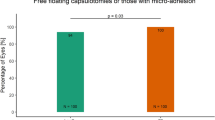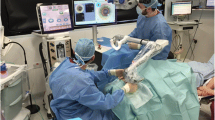Abstract
Purpose
To describe the intraoperative complications and the learning curve of microincision cataract surgery assisted by femtosecond laser (FLACS) with bimanual technique performed by an experienced surgeon.
Methods
It is a prospective, observational, comparative case series. A total of 120 eyes which underwent bimanual FLACS by the same experienced surgeon during his first experience were included in the study; we considered the first 60 cases as Group A and the second 60 cases as Group B. In both groups, only nuclear sclerosis of grade 2 or 3 was included; an intraocular lens was implanted through a 1.4-mm incision. Best-corrected visual acuity (BCVA), surgically induced astigmatism (SIA), central corneal thickness and endothelial cell loss (ECL) were evaluated before and at 1 and 3 months after surgery. Intraoperative parameters, and intra- and post-operative complications were recorded.
Results
In Group A, we had femtosecond laser-related minor complications in 11 cases (18.3%) and post-operative complications in 2 cases (3.3%); in Group B, we recorded 2 cases (3.3%) of femtosecond laser-related minor complications with no post-operative complications. Mean effective phaco time (EPT) was 5.32 ± 3.68 s in Group A and 4.34 ± 2.39 s in Group B with a significant difference (p = 0.046). We recorded a significant mean BCVA improvement at 3 months in both groups (p < 0.05) and no significant SIA nor corneal pachymetry changes in the two groups during the follow-up (p > 0.05). Finally, we found significant ECL in both groups with a significant difference between the two groups (p = 0.042).
Conclusions
FLACS with bimanual technique and low-energy LDV Z8 is associated with a necessary initial learning curve. After the first adjustments in the surgical technique, this technology seems to be safe and effective with rapid visual recovery and it helps surgeons to standardize the crucial steps of cataract surgery.



Similar content being viewed by others
References
Popovic M, Campos-Möller X, Schlenker MB, Ahmed II (2016) Efficacy and safety of femtosecond laser-assisted cataract surgery compared with manual cataract surgery: a meta-analysis of 14 567 eyes. Ophthalmology 123(10):2113–2126
Grewal DS, Schultz T, Basti S, Dick HB (2016) Femtosecond laser-assisted cataract surgery–current status and future directions. Surv Ophthalmol 61(2):103–131
Day AC, Gore DM, Bunce C, Evans JR (2016) Laser-assisted cataract surgery versus standard ultrasound phacoemulsification cataract surgery. Cochrane Database Syst Rev 8:7
Cavallini GM, Campi L, Masini C (2014) B-MICS: origini e definizione. In: Cavallini GM (ed) B-MICS: bimanual micro incision cataract surgery. Modena, Athena ed, pp 1–5
Vasavada V, Vasavada V, Raj SM, Vasavada AR (2007) Intraoperative performance and postoperative outcomes of microcoaxial phacoemulsification; observational study. J Cataract Refract Surg 33:1019–1024
Cavallini GM, Campi L, Masini C, Pelloni S, Pupino A (2007) Bimanual microphacoemulsification versus coaxial miniphacoemulsification: prospective study. J Cataract Refract Surg 33:387–392
Abell RG, Daarian-Smith E, Kan JB, Allen PL, Ewe SY, Vote BJ (2015) Femtosecond laser-assisted cataract surgery versus standard phacoemulsification cataract surgery: outcomes and safety in more then 4000 cases in a single center. JCRS 41(1):47–52
Conrad-Hengerer I, Al Juburu M, Schiltz T, Hengerer FH, Dick B (2013) Corneal endothelial cell loss and corneal thickness in conventional compared with femtosecond laser-assisted cataract surgery: three-month follow-up. J Cataract Refract Surg 39(1307):1313
Reddy KP, Kandulla J, Auffarth GU (2013) Effectiveness and safety of femtosecond laser-assisted lens fragmentation and anterior capsulotomy versus the manual technique in cataract surgery. J Cataract Refract Surg 39(9):1297–1306
Chee SP, Yang Y, Ti SE (2015) Clinical outcomes in the first two years of femtosecond laser-assisted cataract surgery. Am J Ophthalmol 159(4):714–719
Alió JL, Abdou AA, Puente AA, Zato MA, Nagy Z (2014) Femtosecond laser cataract surgery: updates on technologies and outcomes. J Refract Surg 30(6):420–427
Lubahn JG, Donaldson KE, Culbertson WW, Yoo SH (2014) Operating times of experienced cataract surgeons beginning femtosecond laser-assisted cataract surgery. J Cataract Refract Surg 40(11):1773–1776
Grewal DS, Dalal RR, Jun S, Chou J, Basti S (2016) Impact of the learning curve on intraoperative surgical time in femtosecond laser-assisted cataract surgery. J Refract Surg 32(5):311–317
Bali SJ, Hodge C, Lawless M, Roberts TV (2012) Suitton G-early experience with the femtosecond laser for cataract surgery. Ophtalmol 119(5):891–899
Vryghem JC, Devogelaere T, Stodulka PJ (2010) Efficacy, safety, and flap dimensions of a new femtosecond laser for laser in situ keratomileusis. J Cataract Refract Surg 36(3):442–448
Talamo JH, Gooding P, Angeley D, Culbertson WW, Schuele G, Andersen D, Marcellino G, Essock-Burns E, Batlle J, Feliz R, Friedman NJ, Palanker D (2013) Optical patient interface in femtosecond laser-assisted cataract surgery: contact corneal applanation versus liquid immersion. J Cataract Refract Surg 39(4):501–510
Pajic B, Vastardis I, Gatzioufas Z, Pajic-Eggspuehler B (2014) First experience with the new high frequency femtosecond laser system (LDV Z8) for cataract surgery. Clin Ophthalmol 8:2485–2489
Alió JL, Soria F, Abdou AA, Peña-García P, Fernández-Buenaga R, Javaloy J (2014) Comparative outcomes of bimanual MICS and 2.2-mm coaxial phacoemulsification assisted by femtosecond technology. J Refract Surg 30(1):34–40
Abell RG, Kerr NM, Vote BJ (2013) Toward zero effective phacoemulsification time using femtosecond laser pretreatment. Ophthalmology 120(5):942–948
Nagy ZZ, Takacs AI, Filkorn T, Kránitz K et al (2014) Complications of femtosecond laser-assisted cataract surgery. J Cataract Refract Surg 40(1):20–28
Friedman NJ, Palanker DV, Schuele G, Andersen D, Marcellino G, Seibel BS, Batlle J, Feliz R, Talamo JH, Blumenkranz MS, Culbertson WW (2011) Femtosecond laser capsulotomy. J Cataract Refract Surg 37(7):1189–1198
Schultz T, Joachim SC, Kuehn M, Dick HB (2013) Changes in prostaglandin levels in patients undergoing femtosecond laser-assisted cataract surgery. J Refract Surg 29:742–747
Diakonis VF, Yesilirmak N, Cabot F, Kankariya VP, Kounis GA, Warren D, Sayed-Ahmed IO, Yoo SH, Donaldson K (2015) Comparison of surgically induced astigmatism between femtosecond laser and manual clear corneal incisions for cataract surgery. J Cataract Refract Surg 41:2075–2080
Chee S-P, Yang Y, Ti S-E (2015) Clinical outcomes in the first two years of femtosecond laser-assisted cataract surgery. Am J Ophthalmol 159(4):714–719
Conrad-Hengerer I et al (2013) Corneal endothelial cell loss and corneal thickness in conventional compared with femtosecond laser–assisted cataract surgery: three-month follow-up. J Cataract Refract Surg 39(9):1307–1313
Mariacher S, Ebner M, Seuthe AM, Januschowski K, Ivanescu C, Opitz N, Szurman P, Boden KT (2016) Femtosecond laser-assisted cataract surgery: first clinical results with special regard to central corneal thickness, endothelial cell count, and aqueous flare levels. J Cataract Refract Surg 42(8):1151–1156
Author information
Authors and Affiliations
Corresponding author
Ethics declarations
Conflict of interest
None of the authors have conflict of interest with the submission.
Rights and permissions
About this article
Cite this article
Cavallini, G.M., Verdina, T., De Maria, M. et al. Femtosecond laser-assisted cataract surgery with bimanual technique: learning curve for an experienced cataract surgeon. Int Ophthalmol 39, 1–9 (2019). https://doi.org/10.1007/s10792-017-0776-z
Received:
Accepted:
Published:
Issue Date:
DOI: https://doi.org/10.1007/s10792-017-0776-z




